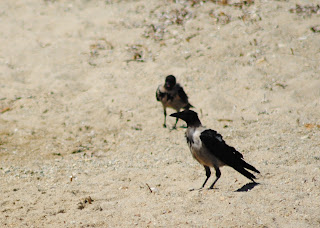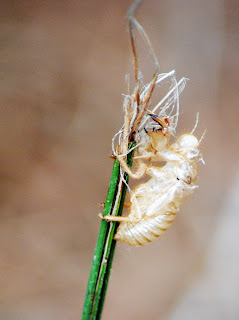Some of the plants and critters from my recent visit to Sardinia in the area around San Teodoro and the coast near Alghero. The first item is a relative of the daffodil Pancratinum maritimum and then a weird flower I can't identify. The dragonfly is probably a Common darter (Sympetrum striolatum). A grasshopper and a bush cricket were also seen. A cicada final nymph stage case was found on vegetation below pines. Lepidoptera included a Hummingbird hawk moth (Macroglossum stellatarum); a probable Brown argus (Aricia agestis); a Long-tailed blue (Lampides boeticus); a Geranium bronze (Cacyreus marshalli) and a possible Geranium argus (Eumedonia eumedon). Hymenoptera included Andrena flavipes; Xylocopa violacea; possible Melecta albifrons and definite Colletes halophilus. Temperature appeared to kill lots of riverine fish resembling Thick-lipped grey mullet (Chelon labrosus). There were also lots of Common wall lizard (Podarcis muralis). Birds included Little egret (Egretta garzetta); Hooded crow (Corvus corone cornix) and fishing Cormorant (Phalocrocorax carbo).
This blog may help people explore some of the 'hidden' issues involved in certain media treatments of environmental and scientific issues. Using personal digital images, it's also intended to emphasise seasonal (and other) changes in natural history of the Swansea (South Wales) area. The material should help participants in field-based modules and people generally interested in the natural world. The views are wholly those of the author.
Friday, 15 September 2017
Sardinian Sojurn
Some of the plants and critters from my recent visit to Sardinia in the area around San Teodoro and the coast near Alghero. The first item is a relative of the daffodil Pancratinum maritimum and then a weird flower I can't identify. The dragonfly is probably a Common darter (Sympetrum striolatum). A grasshopper and a bush cricket were also seen. A cicada final nymph stage case was found on vegetation below pines. Lepidoptera included a Hummingbird hawk moth (Macroglossum stellatarum); a probable Brown argus (Aricia agestis); a Long-tailed blue (Lampides boeticus); a Geranium bronze (Cacyreus marshalli) and a possible Geranium argus (Eumedonia eumedon). Hymenoptera included Andrena flavipes; Xylocopa violacea; possible Melecta albifrons and definite Colletes halophilus. Temperature appeared to kill lots of riverine fish resembling Thick-lipped grey mullet (Chelon labrosus). There were also lots of Common wall lizard (Podarcis muralis). Birds included Little egret (Egretta garzetta); Hooded crow (Corvus corone cornix) and fishing Cormorant (Phalocrocorax carbo).
Subscribe to:
Post Comments (Atom)
-
I n the UK and US, a pparently popular and successful vegan/vegetarian restaurants are reportedly closing or adding meat to their menus ( ...
-
Early ripening fruit may seem convenient but some folk think it confirms environmental stress. There's also a possibility th...





















%20mating%20NWCW.jpg)


No comments:
Post a Comment